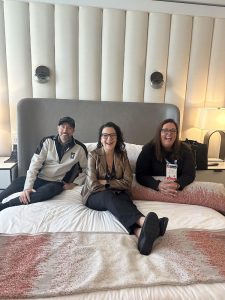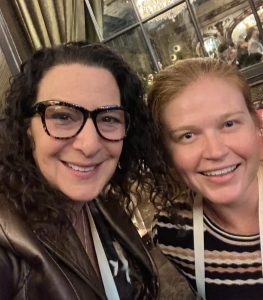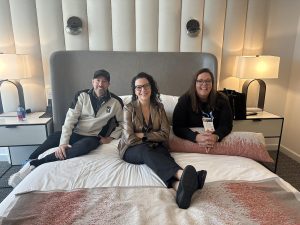Podcast: Play in new window | Download (Duration: 46:08 — 63.8MB) | Embed
Subscribe or Follow Spotify | Android | Pandora | iHeartRadio | TuneIn | Deezer | RSS | More
CES (now an acronym, but AKA the Consumer Electronics Show) has grown beyond just a cool tool and tech showcase to being a place ripe for conversations on cool marketing and ad tech. It was a watershed moment for the attendee count of my media industry cohort, with many remarking that it was like a reunion from the old cable conference days.
I took advantage of seeing friends before leaving Las Vegas to have three enlightening discussions: From Prohaska Consulting and E.W. Scripps’ effort to Rebrand the News and rehabilitate its brand safety perceptions, to Marketing Architects’ construction of proprietary software and its All-Inclusive TV business model, to Barometer’s ability to highlight podcasting’s potential through AI, each of these companies are driving a necessary evolution.
“Too many companies have provided too big of an easy button to let buyers just block news. It’s just a media planning miss that people aren’t doing their jobs properly from a reach and frequency and delivering ROI.” – Matt Prohaska, Prohaska Consulting
No Alternative Facts About Quality News
Segment 1: I chat with Prohaska Consulting CEO Matt Prohaska and Brian Norris, Chief Revenue Officer of E.W. Scripps about an initiative they’re working on called “Rebranding News.” Their new research shows that one third of U.S. marketers are completely blocking news from their media buys over perceived brand safety issues. [ DOWNLOAD at Prohaskaconsulting.com] However, blocking entire news categories means missing out on reaching valuable, engaged audiences and quality journalism.
Brian credits Scripps with delivering “unbiased news from the middle” to what are increasingly “younger, more affluent, multicultural streaming audiences.” He explained that Scripps helps advertisers “combat polarization” with context to make informed brand safety decisions, instead of just completely accepting or rejecting news.

Matt and Brian explain the importance of educating advertisers how not all news content is created equal, and there are plenty of brand safe, non-biased news environments for advertising. (Hear more on this subject in Epi 12 with advisor Lou Paskalis, too.)
Key Takeaway: Blocking all news content can negatively impact reach, frequency and ROI. Brands should take a more nuanced, contextual approach to determining brand safety rather than avoiding news altogether. There is quality journalism worth supporting.
“I don’t think that there’s been a more important time, for viewers, consumers, audiences to have access to great, accurate and truthful news.” – Brian Norris, E.W. Scripps
Rethinking the Agency Model and Streamlining Streaming Buys
Segment 2: Listen to why I spoke with Catherine Walstad, VP of Media and Aaron Lange, SVP of Technology from Marketing Architects….in a bedroom!

(Any way that you can catch a quiet conversation during CES dictates the where.) We discuss their unique “all-inclusive TV” agency model where they make significant in-house investments in creative, strategy, analytics and proprietary technology so their clients only pay for media costs.
Catherine and Aaron also explain the increasingly complex streaming TV landscape with new publishers and platforms launching all the time. That drove Marketing Architects to build their own customizable demand-side platform to simplify the supply chain, get clients better rates, and drive performance.
“We like to call ourselves misfits because I feel like our goal has been to disrupt the traditional agency model.” – Catherine Walstad, Marketing Architects
Key Takeaway: The streaming TV supply chain is complex, but software innovation can help simplify and consolidate for efficiency. Non-traditional agency models focused solely on performance are emerging.
It’s the Sighs That Matters
Segment 3: I catch up with Tamara Zubatiy, Co-Founder of Barometer, an AI-powered platform providing brand safety, suitability and contextual targeting right now well-embraced by most of the top podcast companies, but built in general for user generated content. We discuss Barometer’s proprietary technology that analyzes audio, video and text for nuances — like tone and sentiment — to match podcast content with an advertiser’s unique brand safety needs at scale. This enables even large brands to confidently  advertise in podcasts. Advanced machine learning helps audio analysis goes beyond mere keywords to understand how subjects are discussed.
advertise in podcasts. Advanced machine learning helps audio analysis goes beyond mere keywords to understand how subjects are discussed.
“Some of the secret sauce behind Barometer is it’s not just the sentiment, but it’s the tone. How are you really speaking about the subject?” – Tamara Zubatiy, Barometer
Key Takeaway: Advanced AI that detects tone and sentiment is unlocking podcast advertising opportunities by providing trustworthy brand safety at scale.
Key Moments:
02:20 A little #DYK about #CES
03:10 Meet Prohaska Consulting and E. W. Scripps
06:35 The Role of News in Today’s Society
07:29 The Truth About Fact-Based News
08:47 Why ad blocking all news categories hurts reach and ROI
13:19 Research Fueling the Rebranding of News
15:19 Consumer Viewing Habits and Audiences for News
19:58 Marketing Architects: A Different Kind of Agency
25:46 Understanding DSPs and SSPs
27:48 The Challenges of Navigating the Streaming Landscape
32:03 The Strategy Behind Building a DSP
33:15 The Holistic Approach of Marketing Architects
35:51 An Un-Agency Business Model
39:00 Celeb and Invention Sightings at CES
39:50 A Barometer for Brand Safety
40:45 Building AI for Analyzing Podcast Content and Context
43:37 Understanding GenZ, News and Brand Suitability
44:53 Liked this? Please Buy me a Coffee! buymeacoffee.com/mossappeal





